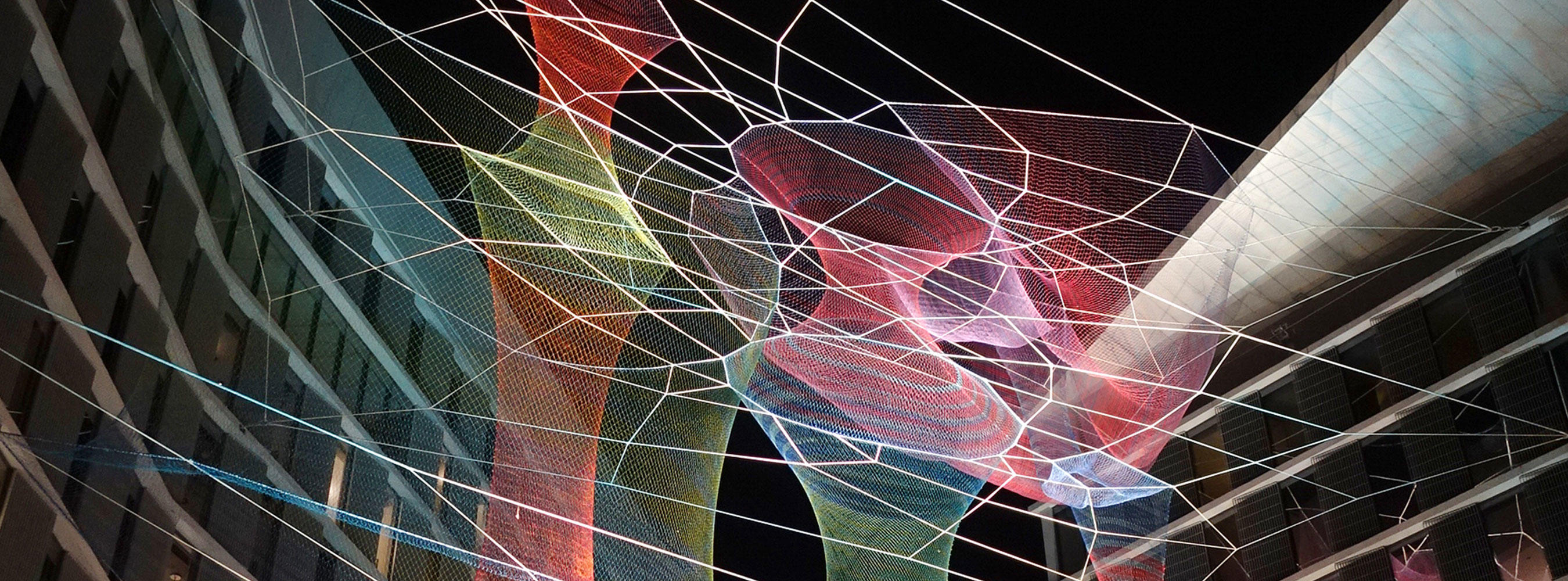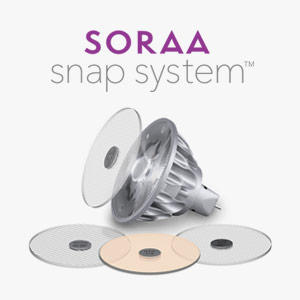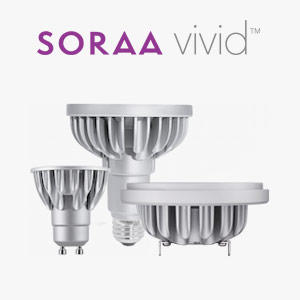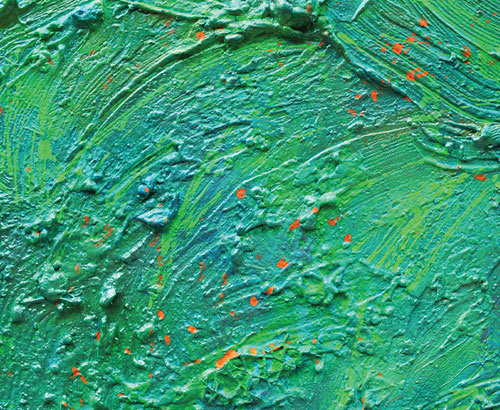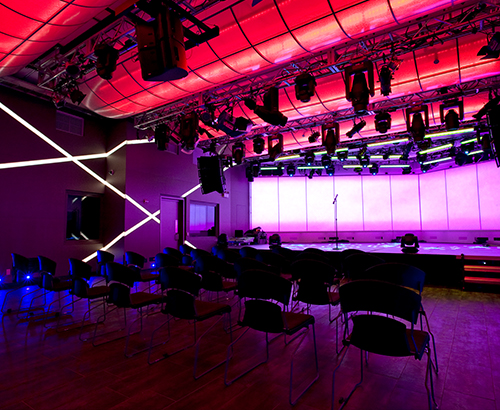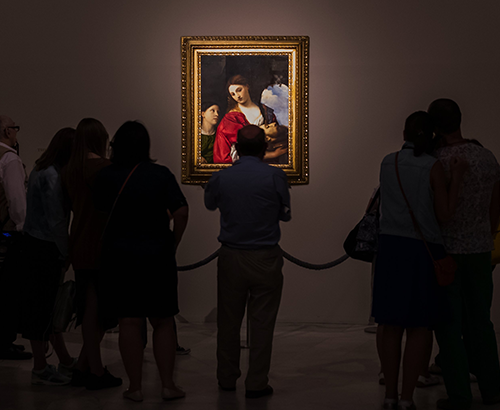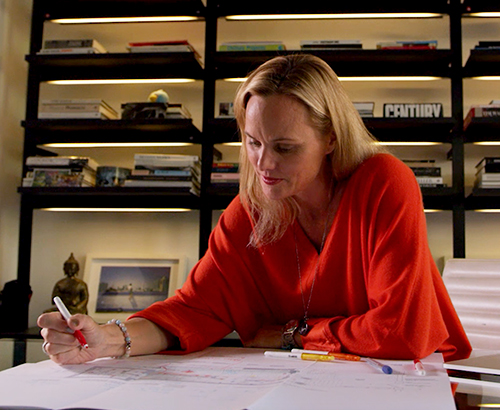Janet Echelman's 'Dream Catcher' Transforms the Sunset Strip with Color & Light
August 2018 - by SORAA
I like this
Billboards and concrete buildings have defined the Sunset Strip skyline in West Hollywood, California, for decades. Passerby may have noticed a colorful, whimsical addition to Sunset Strip’s vista thanks to Dream Catcher, a sculpture constructed of multicolored fibers hanging between two hotel towers, by renowned artist Janet Echelman.
According to Echelman, Dream Catcher was inspired by dreams and the notion of sleeping hotel guests dreaming away within the two towers. Researching colors from brainwave maps advised pigments selected for the work, while special considerations for light complement the immersive viewing experience with playful shadows and vibrant colors.
We spoke with Echelman to learn more about her craft and celebrate her innovative blend of light and color within her work. Learn how the artist transforms urban landscapes with her delicate yet formidable fiber sculptures—and how natural and LED light sources add dimension to her entrancing masterpiece.
SORAA: How did Dream Catcher begin?
Janet Echelman: I was approached by a real estate developer (CIM) who asked if I could create a work for the space outside their newly constructed hotel towers. I envisioned creating a work that laced directly into the architecture at multiple points, knitting the structures together. The result, Dream Catcher, is constructed with four horizontal structural layers suspended between two hotel towers. Between these structural layers float colorful sculptural elements which combine both tensioned and draped forms.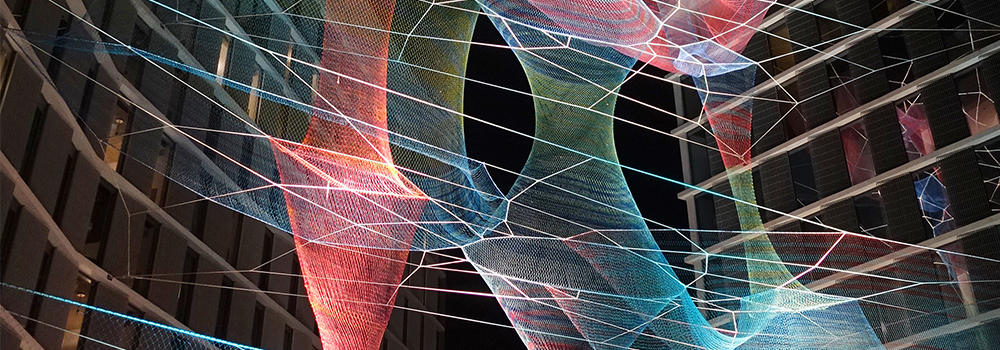
S: What inspired the sculptural project?
JE: The artwork’s inspiration stems from dreams and the idea of dreaming hotel guests asleep in the two buildings that cradle and support the sculpture. My studio’s research into brainwave activity during periods of dreaming provided a data set from which we extrapolated the forms that constitute the artwork. Dreams are not only private experiences; they are also social and cultural ones. The title Dream Catcher speaks not only to the guests of the hotel, but also to the larger region and its identity as a global epicenter for entertainment and media—the place where dreams are invented and pursued.
S: Why did you choose colored lighting as medium?
JE: My goal was to create an iconic illuminated beacon of light within the urban landscape. During the daytime, the gently pulsing fiber casts shadow drawings onto the ground below, and at night the colored light adds another dimension to the artwork. The chromatic drama of Dream Catcher, particularly at night with its LED lighting design, offers a vibrant, illuminated visual field prominent both from Sunset Boulevard and locations south of the site.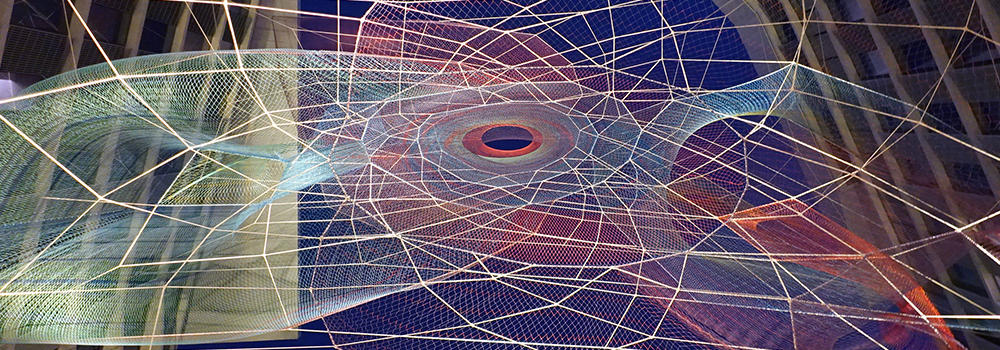
S: Is there a specific reason for choosing multiple colors? If so, why?
JE: The multiple colored lighting scenes that unfold gradually throughout the night are inspired by and expressive of various states of dreaming. Some of the physical fiber colors were inspired by the colors of the scientific mapping of brainwaves during REM sleep.
S: What were the biggest challenges to meeting your artistic goals? How did you solve them?
JE: Technical constraints have pushed my creativity in many of my works and particularly with Dream Catcher. In designing permanent work in sites with unique challenges (climates with extreme weather conditions like typhoon winds, snow and ice storms, or complicated site layouts with multiple buildings like in West Hollywood), I try to approach challenges as a feature rather than a bug.
For West Hollywood, the challenge of creating four horizontal structural layers suspended in both tensioned and draped forms was a new and exciting exploration. This combination proved challenging for our software to accurately simulate, but through much collaboration among our talented team, we were able to create forms new to the practice.
To achieve this, both technology and collaboration were necessary. My studio has been collaborating the past seven years with the world’s leading design software company, Autodesk, to build a custom software tool that allows us to soft-body 3D modeling of our monumental designs while understanding the constraints of our craft, and showing response to the forces of gravity and wind. We couldn’t have built our monumental city-scaled sculptures without it.
Collaboration has always been central to my work. I work with a tight-knit group of architects and artists inside my studio, plus an external team of computer scientists, aeronautical and structural engineers. I also work with independent architecture, landscape and lighting designers, as well as fabricators and artisans.
I describe public art as a “team sport.” Being able to work with so many talented individuals expands the language with which I can speak as an artist. I am always learning from my colleagues, and what we create together is definitely greater than what I could create myself.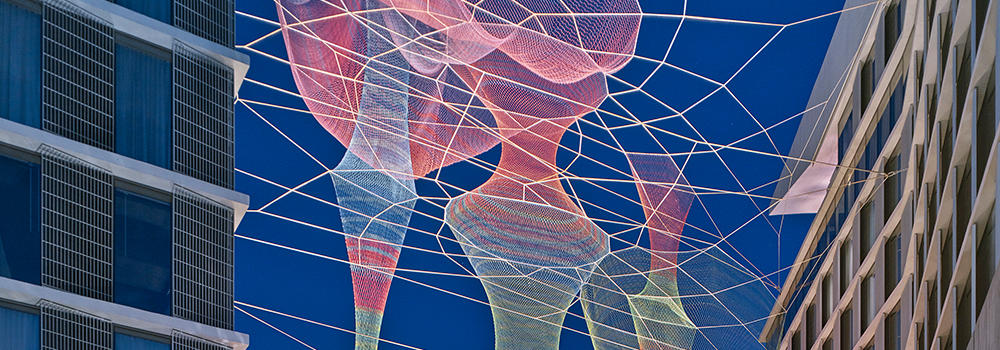
S: What does color mean to you? What role does color play in your work?
JE: In each of my works, I seek a sequence of colors–for both fiber and lighting–that speaks to the preexisting site. It is never quick or easy. I want to make artworks that create an energy in balance with its site–a combination of the right idea, the aesthetic form, optimal proportion and color. Even after years of experience, I still have to search for it every time, never knowing how or when it will come.
S: How does this project complement the surrounding space?
JE: Dream Catcher is designed to transform the open space between the two buildings into a dynamic, translucent art installation. The gently-moving, transparent forms reach nearly the height of the adjacent ten-story buildings and provide a soft counterpoint to their hard edges. It acts as both a contrast and a complement, as it laces seamlessly into the architecture to become one with the urban landscape.
S: What do you want the audience to gain from Dream Catcher?
JE: I leave my work open for each person to complete. My hope is that each person becomes aware of their own sensory experience in that moment of discovery, and that may lead to the creation of your own meaning or narrative.
When I look at the sculpture, I see a physical proof of our ability to work together in shaping our world. It is a reminder of our interconnectedness on every scale. An action in one part of the world can cause ripple effects all over the planet. As an individual, I can sometimes feel powerless. But then I imagine a length of thread, braided and knotted together into these netted forms which exhibit immense strength and resiliency.
S: Did Dream Catcher meet your expectations?
JE: Each artist has different standards for how they measure success in their work. I choose to spend my life creating art in cities around the world, inviting people to have an experience underneath the sculpture and form a relationship with it. If someone pauses to notice the interaction with wind and sunlight as it changes in the midst of their daily life, then it has achieved my personal artistic goal.
When I look back on my work, of course I see all the ways I did not achieve my highest goals for each piece, but as the years pass, I have begun to accept them as they are, try to love them for being the purest expression of that moment. I don’t let myself go back and make changes. I don’t think I am or will ever be completely satisfied with anything I make. Perhaps that’s not a bad thing, because it pushes me forward with the challenge to make the next piece more expressive, more elegantly crafted in thought and material.
S: What feedback did you receive regarding Dream Catcher?
JE: “Spellbound” and “awe” are words we’ve been hearing. People like the way it floats delicately between buildings in contrast to the brash iconic nature of the Sunset Strip.
I’ve been getting feedback that people stop and look up, and slow down for a moment to contemplate amidst their busy lives. And I hear that total strangers have started conversations about the work.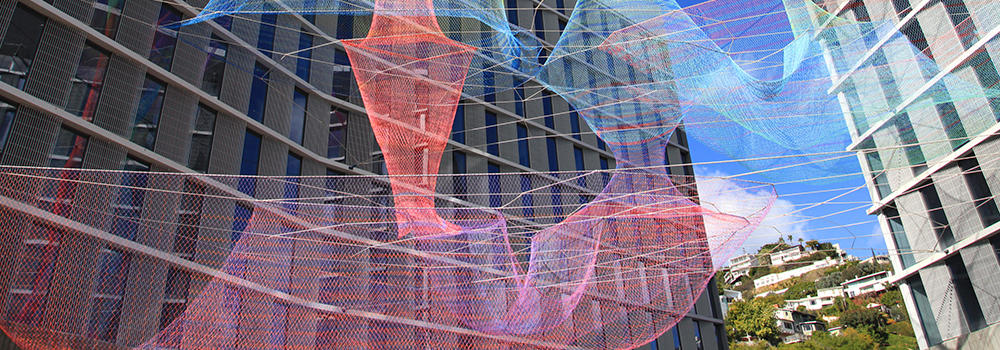
S: Do you think Dream Catcher has an impact on society?
JE: It is a scientifically proven fact that our visual physical context can affect how we feel. It influences how we experience our lives. The way our cities look and function results from the way people choose to build them, and I believe that collectively we have the power to build them differently. My artwork brings an experience of softness to the scale of the city. It is a counterpoint to the hard edges of buildings. It offers proof that we can interrogate the status quo—that the assumption that cities must be formed from hard materials and straight edges can be changed.
S: If you could write your overall philosophy about color and light in one word, how would you articulate it?
JE: Ephemeral.
S: What inspired you to become a sculptor and fiber artist?
JE: When I was a young painter, I traveled on a Fulbright Scholarship to India. Promising to give painting exhibitions around the country on behalf of the U.S. Embassy, I shipped my special paints and equipment to create the new paintings. The deadline for the shows arrived, but my paints did not. I was in a terrible bind, with no materials to make my art. I was staying in a South Indian fishing village, and each afternoon I walked the long beach watching the fishermen bundling their nets into mounds on the sand. I'd seen it every day, but this time I saw it differently—a new approach to sculpture, a way to make volumetric form without heavy solid materials.
My first satisfying sculptures were hand-crafted in collaboration with those fishermen. I brought them to the beach and lifted them into the air to photograph them. It was then that I discovered their soft surfaces revealed every ripple of wind in constantly changing patterns and was mesmerized.
S: How do you hope your work impacts viewers?
JE: I want my work to be as accessible and free as breathing air. Everyone experiences public artwork differently. My hope is that each person becomes aware of their own sensory experience through engaging with my work. That contemplative moment—that moment of pause—can lead each person to create their own meaning or narrative, so I leave it open-ended.
S: What advice would you give to aspiring artists?
JE: Try to pick something that fascinates you and you won’t mind practicing for a very long time. That way, you will always find inner satisfaction whether or not the world praises what you’re doing.
When I started making art, my biggest challenge was learning to hear my inner voice and finding a way to notice and pay attention to my own ideas. I began writing and drawing with my non-dominant hand, which gave me access to my more fledgling, vulnerable ideas that were being overpowered by my more conscious, skilled hand. Once I began to pay attention to these new ideas, the biggest hurdle was to learn how to respect them, and the way to respect an idea is to invest the attention and work needed to develop it. This was difficult but learning to do so was an important step in my growth as an artist.
When developing an idea, I remind myself not to start with compromise. I envision my ideal goal—what would result if I had no limits in resources, materials, or permission? I’ve learned that eliminating options too soon is costly, because many ideas might be more viable than they initially appear. They just need a chance to mature and develop.
If you start with yourself and make sure that you fully believe that what you’re doing will create positive change in the world, then you can go out and share your vision with genuine belief.
And being authentic is the most important thing when communicating about one’s art.
ABOUT THE PROJECT
Name of Client
- CIM
Project Name
- Dream Catcher
Project Location
- 8490 Sunset Blvd, West Hollywood, CA 90069
Date of Project Completion
- 2017
Creative Team
- Art: Janet Echelman
- Studio Echelman Team: Daniel Zeese, Cameron Chateauneuf, Melissa Henry, Mieke Prins, Mia Cross, Betse Frail
- Design Engineer: SOM San Francisco: Alessandro Beghini, Nicole Wang
- Simulation Software Engineering: Autodesk
- Lighting: Francis Krahe & Associates, Walter Berry, with Janet Echelman
